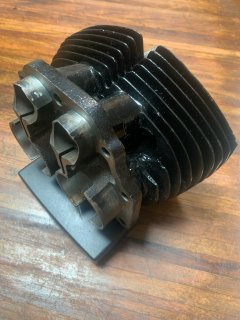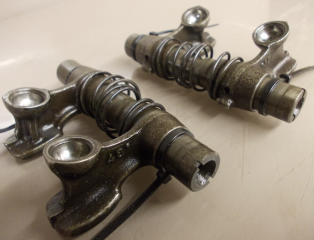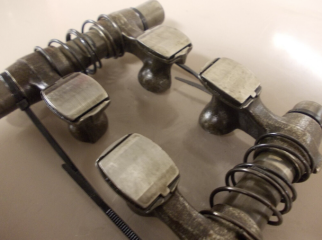You are using an out of date browser. It may not display this or other websites correctly.
You should upgrade or use an alternative browser.
You should upgrade or use an alternative browser.
AN/Hemmings Aluminium Barrels
- Thread starter robs ss
- Start date
Matchless
VIP MEMBER
- Joined
- Dec 23, 2010
- Messages
- 1,119
Matchless twins used followers like those shown. Earlier engines used a shorter version to the later engines. Can't remember the change over year.Those pivoting (unfortunately leading link) lifters in your second photo (post #13) would definitely be lighter, in effect, than the BSA/Triumph ones - even though they are lighter than the STD Norton ones. JS mod is based on these, no?
Most of that Domiracer mod in that photo is a doddle, except the lifters. I'll have a look around at Jap finger lifters from the '80's - maybe some promise there?
Just need them to be short enough to expose the reverse rotating cam to the dribble of oil from above.
Will also need substantially longer pushrods - probably about 2" longer. The pushrods will have to pass through the dams I mentioned in post #16.
More & more interestinger
Cheers
robs ss
VIP MEMBER
- Joined
- Aug 16, 2016
- Messages
- 3,252
Oh - I haven't seen those - will have to investigate.Matchless twins used followers like those shown. Earlier engines used a shorter version to the later engines. Can't remember the change over year.
Probable means AJS twins had the same.
Thanks
- Joined
- Feb 21, 2013
- Messages
- 121
The Domiracer cams/followers were lubricated by a pressure feed through the camshaft centre to oilways in the lobes, just like the Dunstall race cams.As a slight side-line - it appears that some type of dam is required in the lifter tunnels to regulate and direct oil onto the critical cam/follower interface. Not shown in that photo (that I can see)
Cheers
t ingermanson
VIP MEMBER
- Joined
- Oct 17, 2018
- Messages
- 534
Seems the finger lifter would effectively also change the profile, as the lobe would hit and drop the lifter earlier or later (depending on trailing or leading pivot) than a lifter that moves vertically, sharkfinning the cam lobe. Might be an expensive can of worms. Note the pic of the barrels with the finger lifters looks like it hasn't been on a bike but tucked away in a box for a while.Another (weird?) thought is that you could use the finger lifters as a "cam-amplifier" by changing the position of the pushrod-ball socket.
Move the socket forward and increase valve lift for the same cam (and vice versa!)
As I said - interestinger!
Cheers
@Madnorton, a reprint of that poster would be something I'd buy. Don't know if your ownership includes rights to that or not.
robs ss
VIP MEMBER
- Joined
- Aug 16, 2016
- Messages
- 3,252
It would be relatively easy to plot differences in valve lift between the OEM and pivoting lifters. The vertical position of the shaft would have a substantial influence.Seems the finger lifter would effectively also change the profile, as the lobe would hit and drop the lifter earlier or later (depending on trailing or leading pivot) than a lifter that moves vertically, sharkfinning the cam lobe. Might be an expensive can of worms. Note the pic of the barrels with the finger lifters looks like it hasn't been on a bike but tucked away in a box for a while.
@Madnorton, a reprint of that poster would be something I'd buy. Don't know if your ownership includes rights to that or not.
t ingermanson
VIP MEMBER
- Joined
- Oct 17, 2018
- Messages
- 534
Yea. I think a simple CAD program could help figure it out, but getting a one-off cam ground isn't cheap. I'm of course adding my own financial willingness, not yours, to your project, which, admittedly, is a silly thing to do.It would be relatively easy to plot differences in valve lift between the OEM and pivoting lifters. The vertical position of the shaft would have a substantial influence.
robs ss
VIP MEMBER
- Joined
- Aug 16, 2016
- Messages
- 3,252
Okay - I have chickened out (for now)
Pulled the barrel off the 650 and realised how much irreparable work would have to be done - milling off the bottom inch of the lifter/follower tunnels and retainer slots. I'm not going to do that with this barrel.
I will still do the calculations described in the last few posts but will wait until I find a suitable donor barrel.
In the meantime I have closed in on Honda CX500 lifters as a potentially suitable set. I will advise of any progress.
Cheers



Pulled the barrel off the 650 and realised how much irreparable work would have to be done - milling off the bottom inch of the lifter/follower tunnels and retainer slots. I'm not going to do that with this barrel.
I will still do the calculations described in the last few posts but will wait until I find a suitable donor barrel.
In the meantime I have closed in on Honda CX500 lifters as a potentially suitable set. I will advise of any progress.
Cheers



robs ss
VIP MEMBER
- Joined
- Aug 16, 2016
- Messages
- 3,252
I have contacted British Only in Austria for dimensions - they sell new ones of theseOh - I haven't seen those - will have to investigate.
Probable means AJS twins had the same.
Thanks
robs ss
VIP MEMBER
- Joined
- Aug 16, 2016
- Messages
- 3,252
Just done some crude calculations.
My 650 cam has a base circle of about 22.5mm and about 7.4mm lift.
With a 40mm long lifter (centre of shaft to centre of cam pad) with the shaft positioned vertically at mid-lift, the arc the lifter moves through is about 12.5 degrees, almost the same as the backward rake of the lifter/follower tunnels.So - not a substantial effect there.
It now comes down to the size and profile of the "cam pad" on the finge lifter compared to the OEM follower (24.4mm and flat). Those CX500 ones (post #28) look to be about an inch long?
Of course, the "cam pad" on the finger lifter could always be ground to mostly flat, so then there would only be the pivoting angle effect.
My 650 cam has a base circle of about 22.5mm and about 7.4mm lift.
With a 40mm long lifter (centre of shaft to centre of cam pad) with the shaft positioned vertically at mid-lift, the arc the lifter moves through is about 12.5 degrees, almost the same as the backward rake of the lifter/follower tunnels.So - not a substantial effect there.
It now comes down to the size and profile of the "cam pad" on the finge lifter compared to the OEM follower (24.4mm and flat). Those CX500 ones (post #28) look to be about an inch long?
Of course, the "cam pad" on the finger lifter could always be ground to mostly flat, so then there would only be the pivoting angle effect.
robs ss
VIP MEMBER
- Joined
- Aug 16, 2016
- Messages
- 3,252
Thanks - I didn't know that.The Domiracer cams/followers were lubricated by a pressure feed through the camshaft centre to oilways in the lobes, just like the Dunstall race cams.
I think I would make a couple of dams (holes for pushrods + o-rings on pushrods?) sloped downwards towards the front and hole(s) at the front (maybe with shaped "drippers" to direct oil onto the cams as per OEM.
- Joined
- Jun 9, 2008
- Messages
- 1,916
Yes, the poster thing is something we plan to look at we have many general assembly drawings which would make great posters. We even have the Cosworth engine drawings, some of which are related to the ill fated embarrassment that failed and many of an unit twin 8V engine which they should have built.Seems the finger lifter would effectively also change the profile, as the lobe would hit and drop the lifter earlier or later (depending on trailing or leading pivot) than a lifter that moves vertically, sharkfinning the cam lobe. Might be an expensive can of worms. Note the pic of the barrels with the finger lifters looks like it hasn't been on a bike but tucked away in a box for a while.
@Madnorton, a reprint of that poster would be something I'd buy. Don't know if your ownership includes rights to that or not.
mdt-son
VIP MEMBER
- Joined
- Jan 19, 2012
- Messages
- 1,942
As did the lightweight range (G2/G5), Velocette Vpiper/Venom and, as noted, Norton M50/ES2.Matchless twins used followers like those shown. Earlier engines used a shorter version to the later engines. Can't remember the change over year.
I don't know about longer followers for the AMC twins. The only mod I know of is fitment of stellite pads to the followers from 1963 on.
- Knut
mdt-son
VIP MEMBER
- Joined
- Jan 19, 2012
- Messages
- 1,942
I believe JS follower blocks were designed with oriented dripping onto the camshaft in mind. Forget O-rings - pushrods make an angular motion in addition the the vertical motion, so they won't work.I think I would make a couple of dams (holes for pushrods + o-rings on pushrods?) sloped downwards towards the front and hole(s) at the front (maybe with shaped "drippers" to direct oil onto the cams as per OEM.
Best lubrication of the cam is by an internal oilway as per Domiracer design, or directed oil jets, IMO.
- Knut
- Joined
- Apr 6, 2013
- Messages
- 1,405
Somebody bought it. (not me)
Looks like somebody already bought it. (not me)
I see Andover are offering these for (ouch) 1000GBP - https://andover-norton.co.uk/en/sho...-under-68mm-requires-honing-to-finished-size-
Looks like somebody already bought it. (not me)
- Joined
- Apr 6, 2013
- Messages
- 1,405
Anyone know story on this barrel? Looks like it has raised letters cast in the base, "Hemmings Norvil"
- Joined
- Aug 30, 2006
- Messages
- 695
Some 15 years ago, I bought an alloy 850 barrel from Norvil ( Les Emmery) for my Commando.
It has been excellent, except :
1. At the 1st retorque, I pulled the helicoils.
Called Les, and he fell out of the sky ( of course..). I made bronze inserts instead.
2. At 40 000 km after the rebuild, I had to replace a worn camshaft, and found a broken top piston ring.
3. Two years ago, at 80 000 km, I lost compression and found both top rings broken.
The cylinder bores looked perfect, so I just re-ringed after a light hone.
The cam followers were resurfaced when the cam was changed and looked fine, so I didn't inspect the pushrod tunnels.
Oil consumption has always been negligible.
Lately I tend to prefer my N15 over my Commando for travelling.
It used to be 50/50, but now it is more like 80/20.
So in all, The alloy barrels are holding up very well, except for the broken rings.
I know a too small ring gap can cause broken rings, but I don't think that is/was the case.
Many 100 000 kms on Nortons, but I can't recall any broken rings in iron barrels.
Could there be a link between alloy barrels and broken rings?
Seems odd, but it worries me a little.
Head bolts:

It has been excellent, except :
1. At the 1st retorque, I pulled the helicoils.
Called Les, and he fell out of the sky ( of course..). I made bronze inserts instead.
2. At 40 000 km after the rebuild, I had to replace a worn camshaft, and found a broken top piston ring.
3. Two years ago, at 80 000 km, I lost compression and found both top rings broken.
The cylinder bores looked perfect, so I just re-ringed after a light hone.
The cam followers were resurfaced when the cam was changed and looked fine, so I didn't inspect the pushrod tunnels.
Oil consumption has always been negligible.
Lately I tend to prefer my N15 over my Commando for travelling.
It used to be 50/50, but now it is more like 80/20.
So in all, The alloy barrels are holding up very well, except for the broken rings.
I know a too small ring gap can cause broken rings, but I don't think that is/was the case.
Many 100 000 kms on Nortons, but I can't recall any broken rings in iron barrels.
Could there be a link between alloy barrels and broken rings?
Seems odd, but it worries me a little.
Head bolts:

Last edited:
robs ss
VIP MEMBER
- Joined
- Aug 16, 2016
- Messages
- 3,252
Is that barrel Nikasil or steel sleeve?Some 15 years ago, I bought an alloy 850 barrel from Norvil ( Les Emmery) for my Commando.
It has been excellent, except :
1. At the 1st retorque, I pulled the helicoils.
Called Les, and he fell out of the sky ( of course..). I made bronze inserts instead.
2. At 40 000 km after the rebuild, I had to replace a worn camshaft, and found a broken top piston ring.
3. Two years ago, at 80 000 km, I lost compression and found both top rings broken.
The cylinder bores looked perfect, so I just re-ringed after a light hone.
The cam followers were resurfaced when the cam was changed and looked fine, so I didn't inspect the pushrod tunnels.
Oil consumption has always been negligible.
Lately I tend to prefer my N15 over my Commando for travelling.
It used to be 50/50, but now it is more like 80/20.
So in all, The alloy barrels are holding up very well, except for the broken rings.
I know a too small ring gap can cause broken rings, but I don't think that is/was the case.
Many 100 000 kms on Nortons, but I can't recall any broken rings in iron barrels.
Could there be a link between alloy barrels and broken rings?
Seems odd, but it worries me a little.
Head bolts:

Cheers
- Joined
- Aug 30, 2006
- Messages
- 695
Steel sleeve.Is that barrel Nikasil or steel sleeve?
Cheers
- Joined
- Jun 30, 2012
- Messages
- 13,223
I think Jim Schmidt's BSA type lifters are guided in a bronze block. I was thinking about aluminium barrels for my 850, a long time ago - mainly for the weight saving. However I use methanol fuel and I would probably need to warm the motor up a lot longer before riding the bike.
I would much rather go smaller in bore size than bigger. What you pick up on the hurdy-gurdy, you often lose on the merry-go-round. Lighter pistons accelerate faster. The pistons stop and reverse direction at the top and bottom of every stroke. However a Commando engine is relatively slow revving and usually works on the basis of torque rather than top end power. I would not look for more power by going 920. There is no need, a standard size engine can be made to go quick enough, but not without rebalancing the crankshaft. A light crank will not make a torquey motor quicker. Torque is twisting power. Once the heavy crank is spinning, you just need enough power to maintain it. The gearbox is more important. With a light crank, when you change up you lose the inertia effect quicker.
I would much rather go smaller in bore size than bigger. What you pick up on the hurdy-gurdy, you often lose on the merry-go-round. Lighter pistons accelerate faster. The pistons stop and reverse direction at the top and bottom of every stroke. However a Commando engine is relatively slow revving and usually works on the basis of torque rather than top end power. I would not look for more power by going 920. There is no need, a standard size engine can be made to go quick enough, but not without rebalancing the crankshaft. A light crank will not make a torquey motor quicker. Torque is twisting power. Once the heavy crank is spinning, you just need enough power to maintain it. The gearbox is more important. With a light crank, when you change up you lose the inertia effect quicker.
Last edited:
